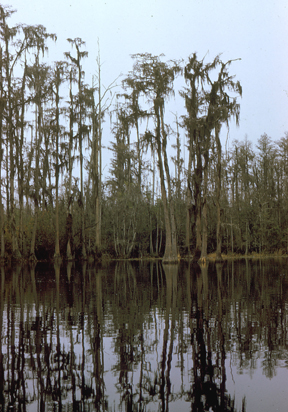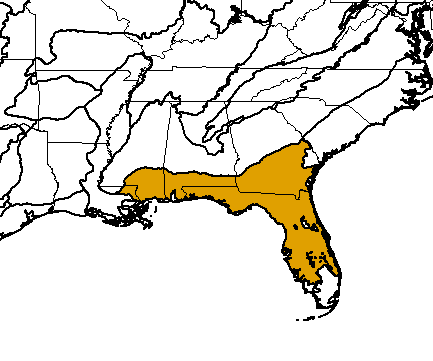
Taxodium distichum (bald cypress), Okefenokee Swamp, Georgia (c) 2004 Maurice J. Kaufmann
Bioimages home (click on an image to enlarge)
view
this page in its intended navigation context
Southeastern Conifer Forests
(WWF
ecoregion
NA0529)

Taxodium distichum (bald cypress), Okefenokee Swamp, Georgia
(c) 2004
Maurice J. Kaufmann

Source of bioregions data:
Olson, D. M. and
E. Dinerstein. The Global 200: Priority ecoregions for global conservation. (PDF
file) Annals of the Missouri Botanical Garden 89:125-126.
Distinctiveness (1=highest,4=lowest): 1
(globally outstanding)
The fire-maintained
Pinus palustris (longleaf pine) -
Aristida stricta (wiregrass) forests may have contained the richest
temperate herbaceous flora on earth with 3417 herbaceous and shrub species.
Tree diversity and endemism are highest in this ecoregion and it also ranks in
the top ten for amphibian, reptile, and bird richness. *
Conservation Status (1=most endangered, 5=most
intact): 1 (critical)
Only about 2% of the habitat in this ecoregion is intact. Most of the
region has been converted to agriculture or tree farms of Pinus elliottii
(slash pine). Fire supression and suburban sprawl are also threats.*
 Pinus palustris (longleaf pine)
(c) 2005 Lisa Kelly
Pinus palustris (longleaf pine)
(c) 2005 Lisa Kelly
 Aristida stricta (wiregrass) (c) 2004
Lisa Kelly
Aristida stricta (wiregrass) (c) 2004
Lisa Kelly
Associated habitats
Okefenokee Swamp, Georgia

Taxodium distichum (bald cypress), Okefenokee Swamp, Georgia
(c) 2001
Maurice J. Kaufmann
hires
Ocala National Forest, Florida

Sabal palmetto (cabbage palmetto)
(trees to 80 ft) and Serenoa repens (saw palmetto). Succession
leads to this if not burned.
(c) 2004
Maurice J. Kaufmann
hires
* Ricketts, T.H., E. Dinerstein, D.M. Olson, C.J. Loucks, et al. (1999) Terrestrial Ecoregions of North America: A Conservation Assessment. World Wildlife Fund - United States and Canada. Island Press, Washington, D.C. pp. 268-271.
Except as noted, images copyright 2002-2004 Steve Baskauf - Terms of use